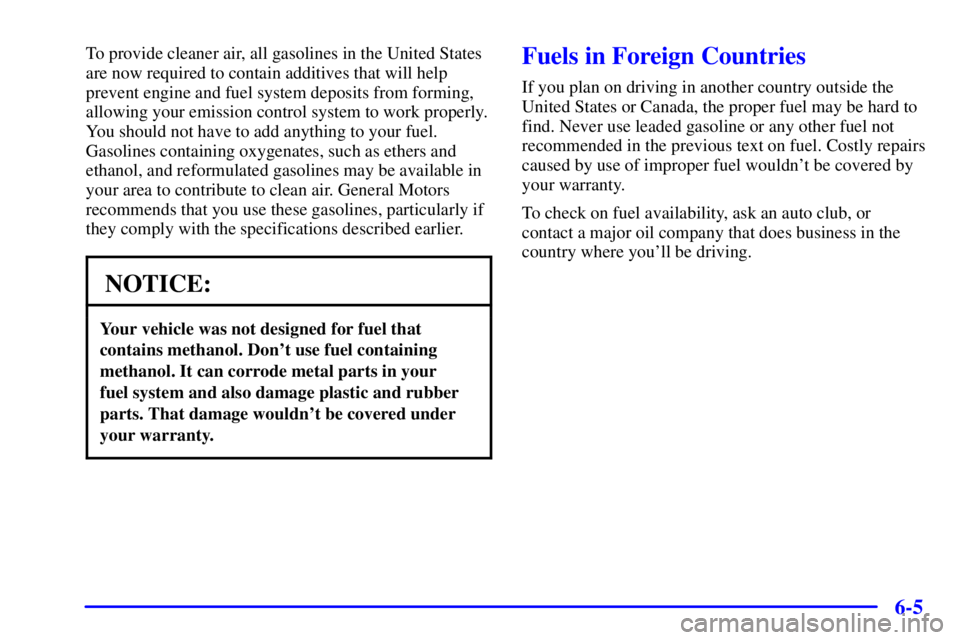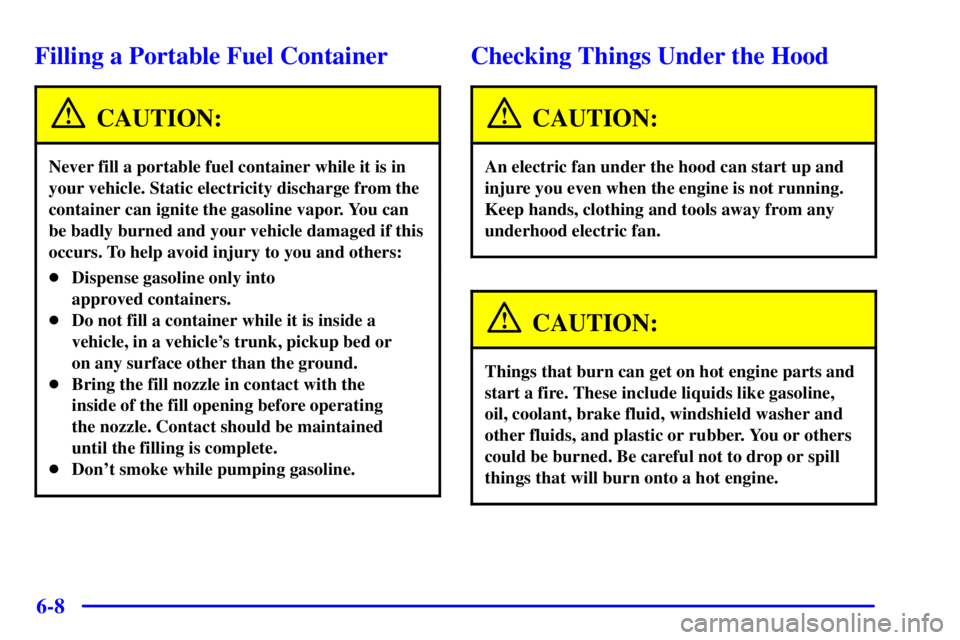Page 267 of 374

6-5
To provide cleaner air, all gasolines in the United States
are now required to contain additives that will help
prevent engine and fuel system deposits from forming,
allowing your emission control system to work properly.
You should not have to add anything to your fuel.
Gasolines containing oxygenates, such as ethers and
ethanol, and reformulated gasolines may be available in
your area to contribute to clean air. General Motors
recommends that you use these gasolines, particularly if
they comply with the specifications described earlier.
NOTICE:
Your vehicle was not designed for fuel that
contains methanol. Don't use fuel containing
methanol. It can corrode metal parts in your
fuel system and also damage plastic and rubber
parts. That damage wouldn't be covered under
your warranty.
Fuels in Foreign Countries
If you plan on driving in another country outside the
United States or Canada, the proper fuel may be hard to
find. Never use leaded gasoline or any other fuel not
recommended in the previous text on fuel. Costly repairs
caused by use of improper fuel wouldn't be covered by
your warranty.
To check on fuel availability, ask an auto club, or
contact a major oil company that does business in the
country where you'll be driving.
Page 270 of 374

6-8
Filling a Portable Fuel Container
CAUTION:
Never fill a portable fuel container while it is in
your vehicle. Static electricity discharge from the
container can ignite the gasoline vapor. You can
be badly burned and your vehicle damaged if this
occurs. To help avoid injury to you and others:
�Dispense gasoline only into
approved containers.
�Do not fill a container while it is inside a
vehicle, in a vehicle's trunk, pickup bed or
on any surface other than the ground.
�Bring the fill nozzle in contact with the
inside of the fill opening before operating
the nozzle. Contact should be maintained
until the filling is complete.
�Don't smoke while pumping gasoline.
Checking Things Under the Hood
CAUTION:
An electric fan under the hood can start up and
injure you even when the engine is not running.
Keep hands, clothing and tools away from any
underhood electric fan.
CAUTION:
Things that burn can get on hot engine parts and
start a fire. These include liquids like gasoline,
oil, coolant, brake fluid, windshield washer and
other fluids, and plastic or rubber. You or others
could be burned. Be careful not to drop or spill
things that will burn onto a hot engine.
Page 272 of 374
6-10 Engine Compartment Overview
When you open the hood of a vehicle with a 3100 V6 (Code J) engine, you'll see:
A. Windshield Washer Fluid
B. Battery
C. Underhood Fuse Block
D. Radiator Fill CapE. Engine Coolant Recovery Tank
F. Power Steering Fluid Reservoir
G. Engine Oil Fill Cap
H. Engine Oil DipstickI. Automatic Transaxle
Fluid Dipstick
J. Brake Fluid Reservoir
K. Engine Air Cleaner/Filter
Page 273 of 374
6-11
When you open the hood of a vehicle with a the 3800 V6 (Code K) engine, you'll see:
A. Windshield Washer Fluid
B. Battery
C. Underhood Fuse Block
D. Radiator Fill Cap
E. Engine Coolant Recovery TankF. Power Steering Fluid Reservoir
(low in engine compartment)
G. Engine Oil Dipstick
H. Engine Oil Fill CapI. Automatic Transaxle
Fluid Dipstick
J. Brake Fluid Reservoir
K. Engine Air Cleaner/Filter
Page 274 of 374
6-12
When you open the hood of a vehicle with a 3800 V6 Supercharged (Code 1) engine, you'll see:
A. Windshield Washer Fluid
B. Battery
C. Underhood Fuse Block
D. Radiator Fill Cap
E. Engine Coolant Recovery TankF. Power Steering Fluid Reservoir
(low in engine compartment)
G. Engine Oil Dipstick
H. Engine Oil Fill CapI. Automatic Transaxle
Fluid Dipstick
J. Brake Fluid Reservoir
K. Engine Air Cleaner/Filter
Page 275 of 374
6-13
Before closing the hood of your vehicle, be sure all the
filler caps are on properly. Then pull the hood down and
close it firmly.
Engine Oil
If the LOW OIL LEVEL
light appears on the
instrument cluster, it means
you need to check your
engine oil level right away.
For more information, see ªLow Oil Level Lightº in
the Index.
You should check your engine oil level regularly; this is
an added reminder.
Checking Engine Oil
It's a good idea to check your engine oil every time you
get fuel. In order to get an accurate reading, the oil must
be warm and the vehicle must be on level ground.
3100 V6 Engine 3800 V6 or 3800 V6
Supercharged Engine
The engine oil dipstick handle is the yellow loop
located near the front of the engine. See ªEngine
Compartment Overviewº in the Index for more
information on location.
Page 276 of 374
6-14
Turn off the engine and give the oil several minutes to
drain back into the oil pan. If you don't, the oil dipstick
might not show the actual level.
Pull out the dipstick and clean it with a paper towel or
cloth, then push it back in all the way. Remove it again,
keeping the tip down, and check the level.
3100 V6 Engine
3800 V6 Engine or 3800 V6 Supercharged Engine
Page 277 of 374
6-15 When to Add Engine Oil
If the oil is at or below the ADD mark, then you'll need
to add at least one quart of oil. But you must use the
right kind. This part explains what kind of oil to use. For
engine oil crankcase capacity, see ªCapacities and
Specificationsº in the Index.
NOTICE:
Don't add too much oil. If your engine has so
much oil that the oil level gets above the
cross
-hatched area that shows the proper
operating range, your engine could be damaged.
3100 V6 Engine 3800 V6 or 3800 V6
Supercharged Engine
The engine oil fill cap is located on the front of the
engine, near the center of the engine compartment and
the yellow
-looped engine oil dipstick. See ªEngine
Compartment Overviewº in the Index for more
information on location.
Be sure to fill it enough to put the level somewhere in
the proper operating range. Push the dipstick all the way
back in when you're through.